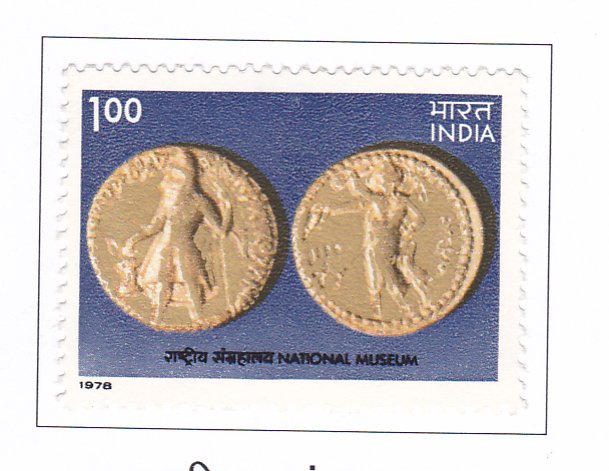Obverse and reverse of Kushan Gold Coin (National Museum)

Technical Data
| Stamp Set | Treasures from Indian Museums |
|---|---|
| Date of Issue | July 27, 1978 |
| Denomination | Rs. 1 |
| Quantity | 2,000,000 |
| Perforation | comb 13½ x 13 |
| Printer | Security Printing Press, Nashik |
| Watermark | No Watermark |
| Colors | Multicolor |
| Catalog Codes |
Michel IN 765 Stamp Number IN 802 Yvert et Tellier IN 561 Stanley Gibbons IN 892 Phila-India IN 766 |
| Themes | Coins | Golden Objects | Museums |
Museums are repositories of the cultural, literary, and artistic heritage of a people. They also offer great potential for education and national integration. The museum movement in India began with the establishment of the Indian Museum in Calcutta in 1814 by the Asiatic Society of Bengal. Following the Ancient Monuments Preservation Act of 1904, numerous archaeological museums were founded. Over the years, more museums have been created to serve different disciplines, including art, archaeology, science, and technology. Today, India has over 360 museums.
In selecting subjects for a series of postage stamps on the Museums of India, the Posts and Telegraphs Department aimed to represent not only the millennia of Indian history but also a variety of artistic expressions from different regions of the country.
The 100 paise stamp, for example, depicts the two sides of a Kushan gold coin from the 1st century A.D., housed in the National Museum, New Delhi. In the early centuries of the Christian era, the Kushans, a branch of the Yue-Chi tribe from Central Asia, established a powerful dynasty in Northwestern India. The coins from this dynasty, particularly those of Kings Kanishka and Huvishka, have survived in large numbers and are an important source of historical information.
The obverse side of the coin shows King Kanishka wearing a cloak and holding a spear in his left hand. The inscription reads “Shaonano Shao Kanishki Kushano,” which translates to “Kanishka, the Kushan, King of Kings.” The reverse side of the coin depicts Lord Shiva with four arms, holding a vase, a drum, a trident, and an antelope. The inscription reads “Oesho,” which refers to Shiva.
